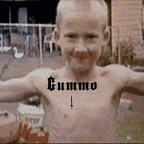

Everywhere you look these days - politics, media, film, visual art, fashion - the idealistic, romantic vision of the United States is reaching a critical mass of decay and eventual rebirth. In 1997, Harmony Korine saw the future, making one of the most brutal and graphic depictions of the underbelly of American society. He metaphorically explicated the dark side of a country, illustrating a darker American aesthetic and exploring the beauty within it.
Gummo centers around Xenia, Ohio, the site of a tornado that devastated the town in the 1970s. Twenty years later, a teenager (Tummler) and a younger tagalong (Solomon) hunt feral cats with air guns, selling them to a local Chinese restaurant in exchange for industrial sniffing glue; and also money for sexual encounters with prostitute who has a brother for pimp. These two form the basis of the narrative structure, but Gummo unfolds mostly around various white-trash vignettes. These other characters roam the landscape, including two teenage girls who seem to be raising their younger sister and a shirtless mute boy who wears pink bunny ears.

Minus Chloe Sevigny and a cameo by director Korine, the entire cast is made up of amateur actors - no doubt selected for their unique, freakish appearance and aesthetic. The acting is unprofessional at times, but this unprofessionalism integral in creating the documentary like social realism atmosphere and aesthetic. The brutishness of the character's conduct is underscored by the cast's lack of confidence in their actions; it gives them a palpable humanity.
The same social realism interacts with a pop aesthetic of the late 1990s. Janet Jackson references interspersed with Slayer's graphic art. The surreality of the film is deliberate, and this juxtaposition feels authentic in representing how middle American looks and feels. Korine stated
"[The film] is a total mix of history and pop, a making sense of pop. To me, that is what is always lacking in film - there's never a relationship to pop culture. America - and I'm not talking about New York and L.A. - is all about this recycling, this interpretation of pop. I want you to see these kids wearing Bone Thugs & Harmony t-shirts and Metallica hats - this almost schizophrenic identification with popular imagery. If you think about, that's how people relate to each other these days, through these images."
The result is an aesthetic that is in no way uniform, or at all contrived - one that is purely weird. No character, or their looks, can be codified into any preexisting lens of interpretation in Gummo; they all represent what Korine describes as "cohesive schizophrenia." This aesthetic is a microcosm for one the overarching message of the film itself. America is a hybrid entity caught in a schism between its history and the present.





Korine is fascinated with trying to find beauty in decay, in the small, forgotten and broken down American towns. He mixes capturing high degrees of isolation with a vibrant naturalism. The environments in Gummo are littered with garbage, but there is still a raw power in the way sunlight and southern rain look on the expansive plains and hills.
It is this uncomfortable, original, and uncompromising aesthetic that makes Gummo such a memorable film. Korine worked with celebrated cinematographer Jean-Yves Escoffier, but that is about as close to any existing history or influence that Korine drew upon for the film; his work is rare in the sense that it is almost totally devoid of reference, it is purely from the artist's imagination.




Perhaps the most famous scene from the film is when Solomon eats spaghetti and chocolate in his moldy bathtub. The bath is filled with a dark green oily fluid, somehow passing as water. Bacon is scotch taped to the bathroom walls. The scene is gut-wrenching; the pungent odor undoubtedly present leaps off the screen and into the viewer's senses, and the silence of everything but the sounds of the water is striking.
Filmmakers and critics continue to debate whether Gummo is a shocking, intellectually pretentious and hollow film, or a challenging work of disturbing art. Regardless what camp you one subscribes to, Gummo is worth viewing. It is unforgettable, from start to finish. Watch it as a compelling study of human beings, the frailty of their relationships, the burden of their haunting loneliness and the painful disconnection with the rest of the living world that such a large segment of humanity endures.


text: Aaron Gray
Recommended For You

